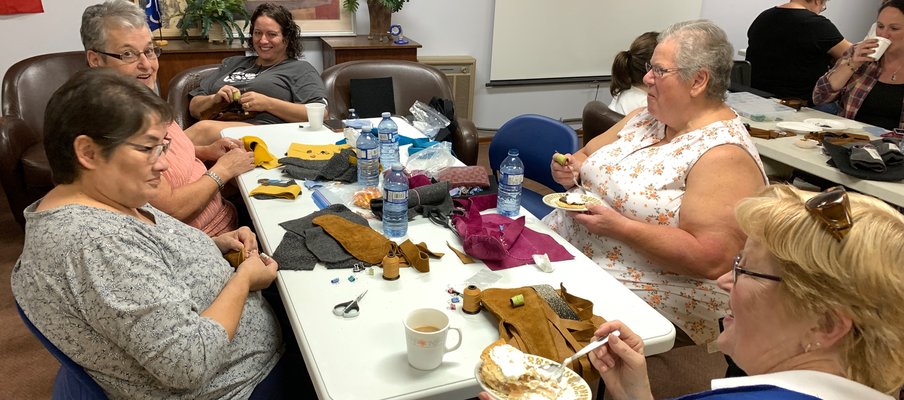
Métis Local Connects Community Through Moccasin-making
In this issue
 Engage - Volume 13, Issue 2, Spring 2023
Engage - Volume 13, Issue 2, Spring 2023
Related Programs
Providing a moccasin-making workshop that eliminated barriers to participation, one that was delivered by a member of the local Métis community, and one that had volunteer and community support, was important to Carla Hope, activity organizer and president of Kinistino Metis Local #43.
Last fall, the Métis Local organized a moccasin-making workshop to revitalize cultural teachings and traditions within its community. Hope wanted to ensure that all members were able to participate without barriers. This included providing a space to gather, providing all supplies necessary, and full access to an instructor.
“This project meets our communities’ need for multi-generational interaction and the sharing of traditional skills and knowledge,” Hope says.
Ronda McQuarrie, a local traditional beader, who has led many moccasin-making workshops previously, eagerly joined the project as an instructor and facilitator. “I have a passion for beading and creating cultural wearable art,” she says. “I feel it is important to keep these traditional art forms alive and pass them on to other people.”
The community recognized the importance as well and the workshop filled up quickly hosting 21 participants – the largest group McQuarrie has instructed within her facilitation work. “It was great to see our youth, adults, Elders and non-Indigenous people socializing and creating together.”
Participants were able to work with moose hide, beaver fur and glass seed beads. With the help and guidance of McQuarrie, they were all able to produce a pair of authentic, hand-stitched, traditional Métis, floral-beaded moccasins, created specifically in a Métis beading style.
“The participants really seemed to enjoy the class and were very happy with their completed moccasins,” she says. “I have had a few people ask me questions since about making more moccasins. [There is a] definite interest in participating in future projects like this one.”
As with any successful event, volunteers, also referred to as ‘Helpers’ in Indigenous communities, played a big role in the delivery of the moccasin-making workshop. McQuarrie says that, the helpers for an event, such as the beading workshop, are largely family and relatives of members of the local who regularly donate their time for community gatherings and events. “Most of this is very informal,” she explains, “and if there is a need for something to get done, they just seem to step up and do it.”
Furthermore, McQuarrie shares, that she is also a volunteer. Her knowledge and skill-set to refine beadwork and moccasin-making, as well as the preparation involved to facilitate, are all done on her own time.
With a successful turnout and eager participants, McQuarrie says that many have continued to work on their beading skills outside of the workshop. “They are taking up this art form and embracing this aspect of their culture,” she says. “They are now able to share it with their children and grandchildren. This class could lead to an intergenerational sharing of culture.”
McQuarrie hopes that more projects like this will continue to happen in her community so she can share her gift with others. “I would love to be able to teach a class on [making] gauntlet mitts, and continue to teach different beading techniques to the community.”
This project received support through the Métis Cultural Development Fund, administered by Gabriel Dumont Institute on behalf of SaskCulture, and funded by Sask Lotteries Trust Fund for Sport, Culture and Recreation.

